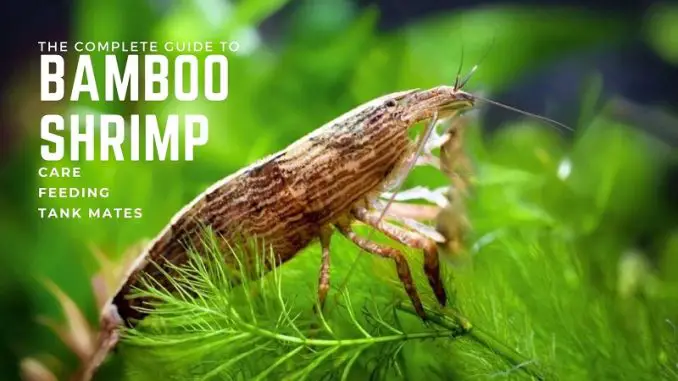
People often turn to invertebrates as a way to add interest to their aquarium. Bamboo Shrimp is a common species that can definitely do this.
They offer some distinctive behaviors that you won’t see from fish or even other shrimp species. The way they filter feed can be particularly captivating.
These creatures are incredibly simple to look after so even beginners can give them a go. It’s just a matter of maintaining a healthy environment, which is what all aquatic pets need.
We have put together all the information you need when caring for Bamboo Shrimp. We’ll cover things like their preferred tank conditions, ideal tank mates, what they eat, and much more.
TABLE OF CONTENTS
Bamboo Shrimp Facts & Overview
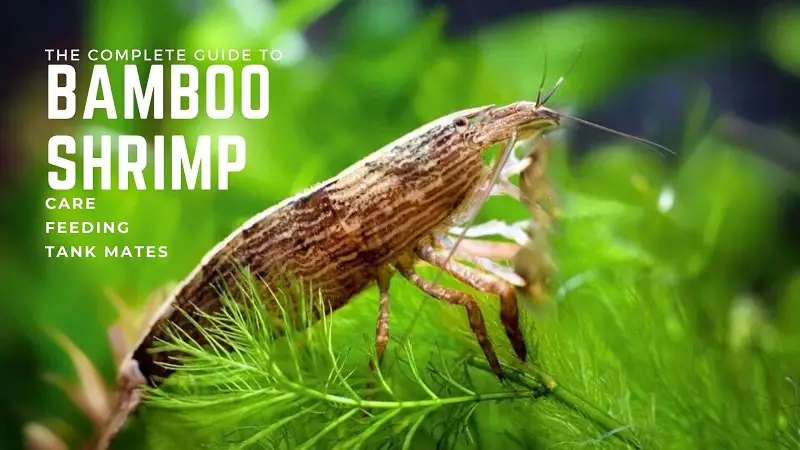
| Category | Rating |
| Care Level: | Easy |
| Temperament: | Peaceful |
| Color: | Reddish-brown |
| Lifespan: | Up to 2 years |
| Size: | 2-3 inches |
| Diet: | Omnivore |
| Family: | Atyidae |
| Minimum Tank Size: | 10 gallons |
| Tank Set-Up: | Freshwater with plants and rocks |
| Compatibility: | Peaceful community |
Bamboo Shrimp are a common sight in freshwater aquariums, especially now that keeping invertebrates has become more popular.
Their popularity means that they are commonly bred, so they should be sold in a pet store near you. If you can’t find any then look online for stores that stock them.
Their price can vary depending on their size. Smaller shrimp typically fall within the $3-$6 range.
When searching for this species, you might see them labeled under a few different names. These include Asian Filter Feeding Shrimp, Fan Shrimp, Flower Shrimp, Singapore Flower Shrimp, Singapore Shrimp, Singapore Wood Shrimp, and Wood Shrimp.
The scientific name for Bamboo Shrimp is Atyopsis moluccensis. They are crustaceans that fall into the Atyidae family.
The only other member of the genus is Atyopsis spinipes. The two species look very similar and could easily be mixed up. The main difference is the number of teeth on the underside of the rostrum (A. moluccensis has >6)
Bamboo shrimp are native to Southeast Asia. Populations are common in mainland India as well as islands such as Sri Lanka and the Samoan Islands.
These areas provide a warm tropical habitat that will need to be recreated to keep healthy shrimp at home. If kept properly, a healthy Bamboo shrimp will live for up to 2 years. Some shrimp may survive even longer.
Don’t be disheartened if some die soon after being introduced to the tank, this can happen due to the stress of transport or the shock of new water conditions.
Make sure that any shrimp you buy have all their legs and antennae. They should also be active and display their color.
Typical Behavior
Like most shrimp species, Bamboo Shrimp are peaceful and inoffensive tank mates, ideal for a peaceful community.
They generally keep to themselves, continuing a never-ending search for food. You will notice them traversing the various surfaces in your aquarium to find a spot where they can filter food from the water.
Expect your shrimp to molt every couple of months. This is an important process that ensures they retain a strong exoskeleton as they grow.
The process leaves a molted shell sitting at the bottom of the tank. Don’t be fooled into thinking it is a dead shrimp!
You could leave the shell in the tank for a few days to see if they consume it for nutrients, but it should be removed if they ignore it.
If a shrimp is about to molt, it usually hides behind plants or decorations for a couple of days to use as protection while it is vulnerable.
Regularly check on hiding shrimp, as this behavior could be a signal that something is wrong (which we’ll talk about later).
Appearance
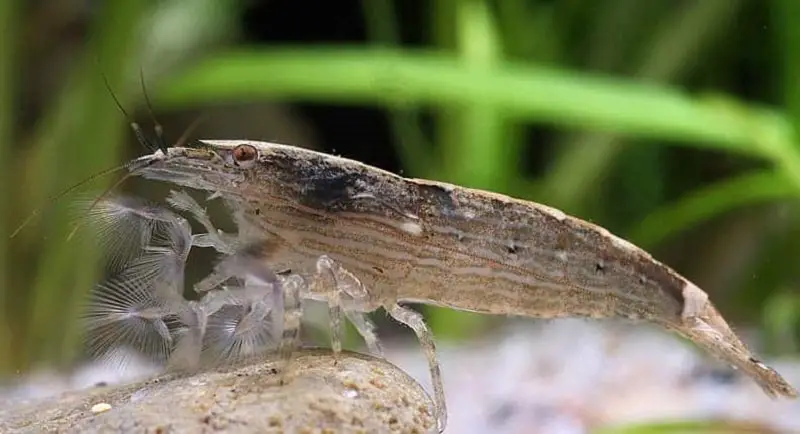
Bamboo Shrimp may not boast an array of bright colors and patterns, but that doesn’t mean they can’t make a big impact on the aesthetic of your aquarium.
Most shrimp fall somewhere on the reddish-brown color scale, but this is prone to change. Sometimes their color shifts to green or orange, which isn’t necessarily a sign that something is wrong.
You might notice your shrimp go pale occasionally, this can be due to a couple of things. It could be because they are stressed, in which case the color change would be brief.
They are also paler after molting, which will last a little longer until the new shell has developed and hardened.
A healthy Bamboo Shrimp can reach up to 2-3 inches, which is often larger than people expect. Stretching down the length of their back is a pale stripe.
Their body resembles that of a stereotypical shrimp, which most people can probably imagine. There are a few interesting features to be aware of.
To extract food from the water, these shrimp have a set of “fans”. They hold them against the current to catch food and move them to their mouths to eat it.
On the top of their heads are eyestalks and antennae, which hold the eyes and sense the environment respectively.
The body is made up of a carapace and six abdominal segments, allowing the abdomen to bend. The sixth segment is the tail.
There are a few subtle differences between males and females. Females have a larger abdomen and longer pleopods, while male is slimmer.
Males also have a different first pair of limbs. They have small, well-developed claws which they use during mating.
Habitat and Tank Conditions
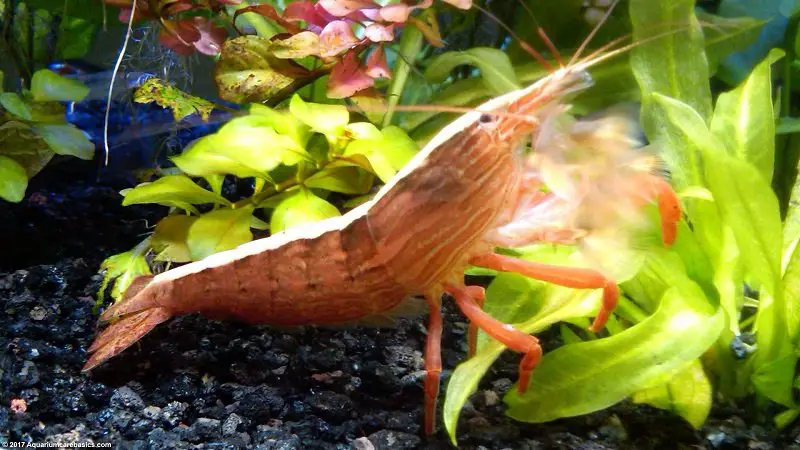
If you’ve kept fish before then you’ll know that their environment must be perfect if you want them to stay healthy. Shrimp are the same.
The best way to keep Bamboo Shrimp happy is to recreate their natural habitat in your aquarium. We’ll outline the perfect conditions later, but it’s useful to know where they live in the wild.
The species is native to the tropical climate of Southeast Asia, specifically Sri Lanka, the Samoan Islands, Japan, India, and the Malay Peninsula.
They live in slow-moderate moving streams and rivers. They can be found in large numbers here, but they are happy being solitary too.
The warm waters would be slightly alkaline and receive plenty of light.
At the riverbed, where Bamboo Shrimp spend most of their time, there would be an abundance of plants and rocks. These offer shelter, as well as places to perch when trying to filter feed.
Understanding their natural habitat gives you a good idea of what your aquarium should resemble.
Next, we’ll discuss the specifics of how to set up your tank.
Tank Conditions
Starting with the bottom of the tank, layer the floor with a substrate. These shrimp will be fine with gravel, but fine sands are preferred by much tropical fish, so consider what potential tank mates might need.
Spread rocks, decorations, and plants on top of the substrate. Your Bamboo Shrimp will climb over these in an effort to find a current to feed on.
Plants are also useful because they ensure that there are small bits of vegetation floating in the water for your shrimp to remove and eat.
You will need a heater to maintain a temperature of 75-81°F. The pH should be 7.0-7.5.
A filter is essential for keeping the aquarium clean. Bamboo Shrimp enjoy sponge filters because they can sit on them and use the current from the filter inlet when feeding.
The filter outlet will likely create enough water movement throughout the tank. An air pump could help with this (and oxygenate the water) but a water pump would be excessive.
Standard aquarium lighting is fine.
What Size Aquarium Do They Need?
The tank needs to be big enough for water to move around. A 10-gallon tank is fine if it is longer than it is high since this will produce a better current. A 20-gallon tank or larger is ideal.
Generally, the bigger the tank, the better.
How Many Can Be Kept Per gallon?
Try to give your shrimp as much space as possible. Aim to have 20 gallons of water for each additional shrimp.
Tank Mates
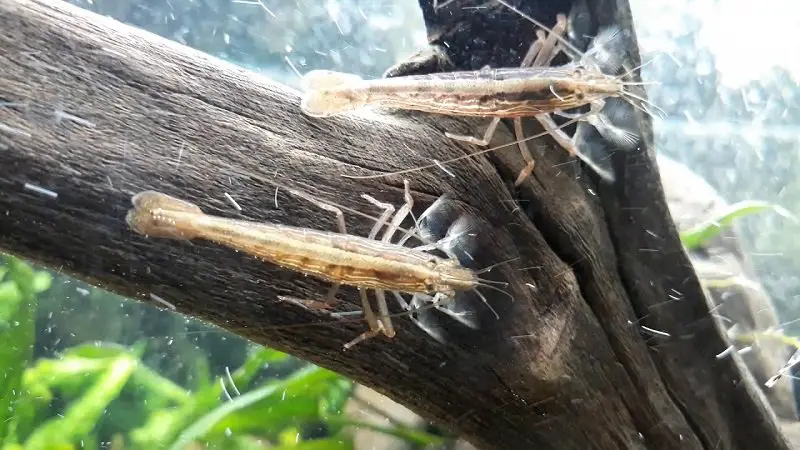
These are incredibly peaceful crustaceans that can be kept with a wide array of tank mates.
Natural populations would be used to living around a mixture of fish and other invertebrates, so they make great additions to a peaceful community aquarium in captivity.
When choosing fish, stick to small-medium-sized species. Shoaling species like Tetra, Danio, and Guppies are good options. Other mid-water swimmers include Gouramis and Bettas.
To give your Bamboo Shrimp company in the lower regions, you could choose Yoyo Loaches, Kuhli Loaches, or Otocinclus Catfish.
Avoid larger fish or cichlids because they will view shrimp as food.
Keeping Bamboo Shrimp with other invertebrates can be a great way to diversify the bottom of your tank. You could try other shrimp species (such as Amano Shrimp and Ghost Shrimp) or add some snails (such as Assassin Snails or Nerite Snails).
Not all freshwater invertebrates are suitable though, like crayfish, which will eat your shrimp. Always research the temperament of any tank mates.
Keeping Bamboo Shrimp Together
Bamboo Shrimp get on with each other very well.
In the wild, they can be found in high densities. You can keep them in groups at home too if you have enough space in the tank.
Though they are often solitary creatures, they’ll probably be grouped up if you keep many individuals. This isn’t just a social behavior; they’ll have all identified the same spot as a good place for filter feeding.
They won’t show aggressive behavior towards each other, even if they are all jostling for the same position.
Diet
This species is a filter feeder. After finding a spot with a moderate current, they sit there and extend specialized appendages to extract any plant matter, microorganisms, or particulate fish food that moves past.
If you watch closely, you’ll see them move these appendages to their mouth every couple of seconds.
This is how they get the majority of their food, both in the wild and in the aquarium. Filter feeding is not a feature of all freshwater shrimp.
This means that most of the time they can be left to their own devices. There should be food in the water column, especially if you’re adding food for fish.
If the substrate gets disturbed, particulate food can be mixed up into the water column, providing extra food. This could happen while cleaning the tank or if a decoration is unearthed. Your shrimp will likely become more active during these times.
Keeping plants in the tank also helps to ensure that there is some plant matter circulating through the aquarium.
Any food you add should be very fine. This could be dried foods like high-quality ground-up flakes; frozen foods like daphnia, or live foods like brine shrimp nauplii or decapsulated eggs.
It’s rare that Bamboo Shrimp will search the bottom of the tank for food. It is usually a sign that there is no food in the water, so you should feed them more.
This behavior is particularly common in newly added shrimp because shops often starve their stock. You may have to feed them extra portions for the first few days.
Care
Bamboo Shrimp are pretty easy to care for. They don’t have any special requirements and they look after themselves most of the time.
However, they need their preferred conditions to be maintained, just like any aquatic pet would. Cleaning the tank is important, such as water changes and wiping away algae.
If you notice an old shell from molting, you can leave it for a couple of days. Sometimes shrimp come back to eat them because they are full of nutrients. Remove it if they don’t show interest though.
The same is true for dead shrimp. Sometimes the remaining shrimp will eat the dead tank mate for the nutrients. Remove the dead shrimp if it is left alone though.
If you notice that a shrimp has remained motionless for a long time, then there may be something wrong.
It could just mean that they are getting ready to molt, but if they are still not moving or eating after a couple of days, then there is probably an issue in the tank.
Use a testing kit to check the parameters of the environment and immediately fix any problems. You should be doing this every week.
It is unlikely, but shrimp can pick up or transmit diseases just like fish. Diseases could come in many forms, such as bacterial infections, fungal infections, or parasites.
These can be problematic when trying to farm shrimp.
The disease could be introduced with new tank mates from a store, or by adding secondhand equipment. If you spot a sick one, isolate the infected individual. There are plenty of treatments available to help nurse them back to health.
Before adding any chemicals (such as medications) to your aquarium, ensure that they don’t contain copper. This is toxic to Bamboo Shrimp, and most other invertebrates.
Breeding
Breeding Bamboo Shrimp is no easy feat. This is not the species to choose if you want to start a shrimp breeding tank, Ghost Shrimp or Cherry Shrimp would make easier options.
Perhaps the biggest problem is that juveniles need brackish water to develop properly, but adults cannot survive in brackish water. This makes transferal and acclimatization of larvae to the brackish water difficult.
If you are determined to breed them, here’s what you need to know.
It is best to have a male to female ratio of 1:1. Luckily, they are easy to sex, as we covered earlier.
A female will carry up to 2000 orange eggs on her abdomen for 30-40 days. These will turn brown as they develop, then hatch into tiny floating larvae.
These larvae must be transferred to brackish water quickly. The salinity level should be about 1.024. They will likely die if left in freshwater for 2-3 days.
You will need an appropriate sponge filter to ensure that the small larvae aren’t taken in with the water.
Choosing a diet for the larvae can be difficult. Small doses of green marine water have been reported to work well.
After 90 days the larvae will have metamorphosed, at which point they only swim forwards. They can then be reintroduced to your main aquarium, but make sure to acclimatize them to freshwater first by gradually lowering the salinity.
Most stocks of Bamboo Shrimp in stores are wild-caught because they are so difficult to breed.
Are Bamboo Shrimp Suitable for your Aquarium?
You should now feel confident about whether Bamboo Shrimp is for you. It’s a matter of personal preference since they are very easy to care for so anyone can keep them.
Their only additional requirement over fish is that you might have to remove a molted shell once in a while.
If you want some for an already established tank, then you must consider whether the water conditions and tank mates are suitable. Most peaceful freshwater communities are a good match.
You will run into difficulties if you’re trying to breed them, but most people accept that their efforts would be futile. Look at alternative species if you want a breeding tank.
Bamboo Shrimp make wonderful tank mates and are a great choice if you have the space for them.
Are Bamboo Shrimp your favorite shrimp species? Let us know why in the comments below…

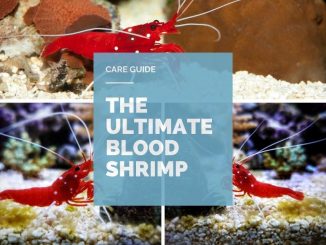
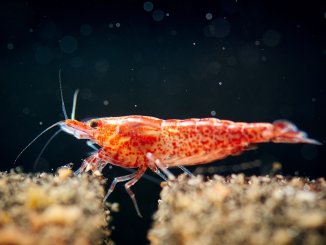
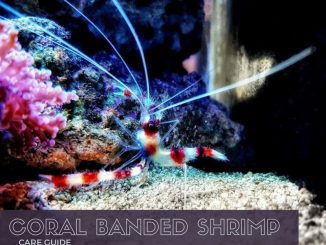
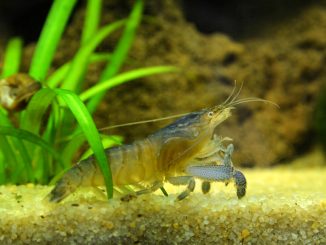
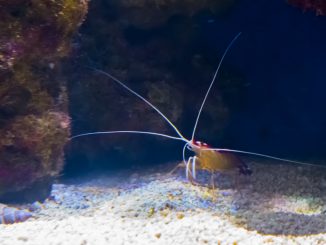


Do Bamboo shrimp regenerate broken antennae after a molt?